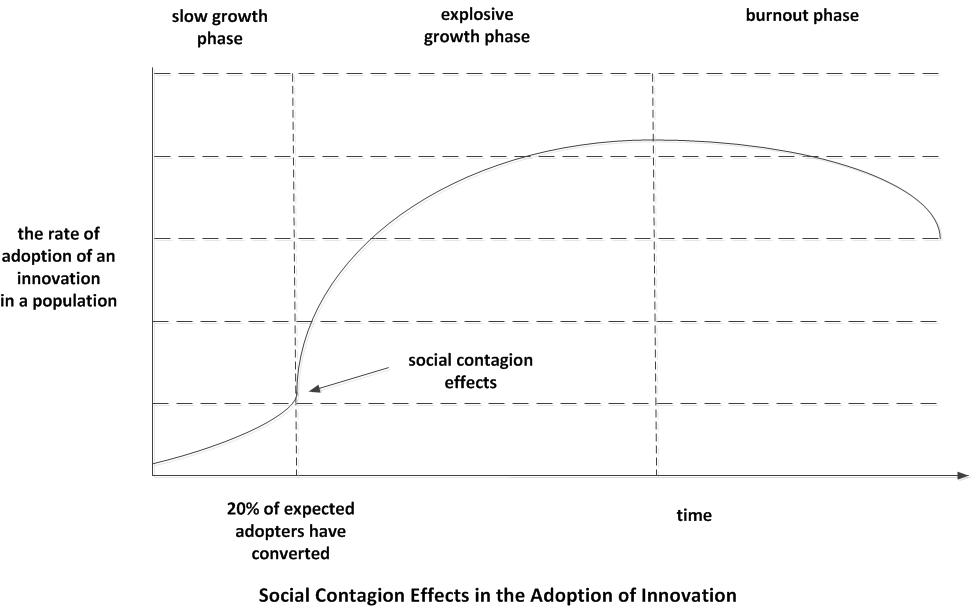The art and science of how to "diffuse" or propagate an innovation into a population has been the work of many applied social scientists, psychologists, and researchers. After all, various organizations have impetuses to sell certain products, lifestyles, behaviors, and values--for their various interests. If there are efficient and effective ways to diffuse innovations, then most organizations will pursue those efforts. Some of these endeavors include advertising and marketing; they include using people's homophilous social networks to reach other potential like-minded individuals or "reference group".
"Contamination" in a Social Network: All sorts of things move through a social network. The adoption of new things in a network is called "contamination".
What Moves through a Social Network: These things that move through a network--ideas, resources, information, techniques, attitudes, behaviors, infections like STIs (sexually transmitted infections) and diseases like STDs (sexually transmitted diseases), and products--may be considered positive or negative (or neither), depending on the individual ego node and on the social network. Innovations are generally seen as positive, but that again is a subjective approach. It may well be that certain ideas and practices may promote the diffusion of a particular product, so there are "interaction effects" between elements that are diffused in a social network.
Accelerators for Diffusion: Certain individuals are seen as accelerators of innovations. Certain "fat nodes" may have outsized impacts as "leaders" in particular social environments. Those with low thresholds for infectiousness (meaning that they are open to innovations in the system) are likely to be highly responsive to adopting new elements diffusing through the social network. (Sometimes, social competition--like "keeping up with the Joneses"--may be a factor in adoption of particular innovations.)
Saturation in a Social Network: "Percolation" refers to a certain point of saturation when an epidemic suddenly sparks and spreads quickly. Until that percolation point, an epidemic may remain silent and unseen.
Those with higher thresholds may reach the limit of pressure when all the direct nodes one degree out (directly connected) have all converted. This assumes a kind of peer pressure influence.
Not Correlational Predictiveness: The research does not show a clear correlational predictiveness about innovation though, so the researchers have gone to examining the various uniqueness of nodes to understand why some convert, and others do not. There is not a systematic relationship of adoption of innovations. In that light, researchers have started looking more closely at the attributes of individual nodes--such as personality, decision-making, preferences, and other aspects, that may influence whether that node (individual) adopts something new.
The way the various "diffusion of innovation" scenarios manifest will differ based on the element that is studied as well as the particular social network. Further, how the diffusion is measured will affect the data.
0 or 1, No or Yes: In a sense, people can choose the binary "no" or "yes" regarding such innovations that come through their social networks. To choose suggests multiple dependencies: awareness, choice, and volition. Oftentimes, though, elements may move through a social network with such speed or silence that people do not notice the adoption. Or they may not realize they have a choice (or further, they may not actually have a choice). Sometimes, emotions carry the day, so choices are not logical cognitive ones but are affective or emotion-based. Other choices are made passively--through non-action (such as not opting out).
Groupthink at one Extreme: In terms of group decision-making, this diffusion can become insidious, with everyone lining up behind an idea that is first mentioned ("the Abilene Paradox") in a way that may be unthinking and detrimental to choices. To avoid this, some groups assign individuals to provide "minority report" opinions. Others work hard to create an open atmosphere, so that a variety of opinions may be welcomed at any time. Research has found that having even one dissenter to a majority opinion may open the way to a wider range of ideas considered. A dissenting opinion may break the spell of a dominant idea.
The psychological phenomena of "cognitive dissonance" may mean that people will discount conflicting information from what they have committed to mentally. Dr. Daniel Kahneman also talks about the WYSIATI ("what you see is all there is") phenomena, which can lead to poor decision-making when people think they have sufficient information and stop looking further (or stop sampling the environment for more information).
Diffusion of Innovation

The above curve assumes that sufficient momentum may be achieved if a certain proportion of a population (critical mass) may buy into a new approach, and at the 20 percent mark "go viral" with people sparking each other to adopt.
|
Let's Talk!
References
Underwood, P. & Welser, H.T. (2011). 'The Internet is Here': Emergent coordination and innovation of protest forms in digital culture. In iConference. Seattle, Washington. ACM. 304 - 311.
|